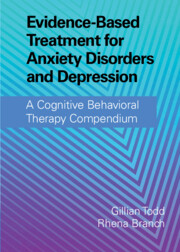 Evidence-Based Treatment for Anxiety Disorders and Depression
Evidence-Based Treatment for Anxiety Disorders and Depression Book contents
- Evidence-Based Treatment for Anxiety Disorders and Depression
- Evidence-Based Treatment for Anxiety Disorders and Depression
- Copyright page
- Contents
- Figures
- Tables
- Contributors
- 1 Introduction
- 2 The History and Philosophical Underpinnings of CBT:
- Part One Cognitive Behavioral Therapy for Anxiety Disorders
- Part Two Cognitive Behavioral Therapy for Posttraumatic Stress Disorder
- Part Three Cognitive Behavioral Therapy for Obsessive-Compulsive Disorder and Associated Disorders
- Part Four Cognitive Behavioral Therapy for Depression
- Part Five Complexity and Comorbidity in Anxiety Disorders and Depression:
- Part Six Specialist Applications of Cognitive Behavioral Therapy for Anxiety Disorders and Depression
- 24 The Application of CBT for Adults with Learning Disabilities
- 25 Cognitive Behavioral Therapy for Children and Adults with Autism
- 26 Adapting CBT for Treating Anxiety Disorders and Depression in Adults with ADHD
- 27 Adapting CBT for Children and Adolescents with Anxiety Disorders and Depression
- 28 Adapting Cognitive Behavioral Therapy for Older Adults with Anxiety Disorders and Depression
- 29 Cross-Cultural CBT
- Part Seven Future Developments
- Appendices
- Index
- References
26 - Adapting CBT for Treating Anxiety Disorders and Depression in Adults with ADHD
from Part Six - Specialist Applications of Cognitive Behavioral Therapy for Anxiety Disorders and Depression
Published online by Cambridge University Press: 06 January 2022
- Evidence-Based Treatment for Anxiety Disorders and Depression
- Evidence-Based Treatment for Anxiety Disorders and Depression
- Copyright page
- Contents
- Figures
- Tables
- Contributors
- 1 Introduction
- 2 The History and Philosophical Underpinnings of CBT:
- Part One Cognitive Behavioral Therapy for Anxiety Disorders
- Part Two Cognitive Behavioral Therapy for Posttraumatic Stress Disorder
- Part Three Cognitive Behavioral Therapy for Obsessive-Compulsive Disorder and Associated Disorders
- Part Four Cognitive Behavioral Therapy for Depression
- Part Five Complexity and Comorbidity in Anxiety Disorders and Depression:
- Part Six Specialist Applications of Cognitive Behavioral Therapy for Anxiety Disorders and Depression
- 24 The Application of CBT for Adults with Learning Disabilities
- 25 Cognitive Behavioral Therapy for Children and Adults with Autism
- 26 Adapting CBT for Treating Anxiety Disorders and Depression in Adults with ADHD
- 27 Adapting CBT for Children and Adolescents with Anxiety Disorders and Depression
- 28 Adapting Cognitive Behavioral Therapy for Older Adults with Anxiety Disorders and Depression
- 29 Cross-Cultural CBT
- Part Seven Future Developments
- Appendices
- Index
- References
Summary
There is compelling evidence supporting the use of cognitive behavioral therapy (CBT) to treat depression and anxiety disorders; furthermore, recent evidence supports the use of CBT to treat attention-deficit/hyperactivity disorder (ADHD) in adults as well. High comorbidity among these conditions requires healthcare providers to recognize and treat problems with anxiety and depression in adults with ADHD, or ADHD in adults with anxiety and depression. This chapter reviews relevant research on the comorbidity of internalizing conditions in adults with ADHD and provides three guiding principles for tailoring CBT to treat depression and anxiety disorders in adults with ADHD: comprehensive case conceptualization, addressing therapy-interfering behaviors, and a functional approach to cognitive and behavioral avoidance.
Keywords
- Type
- Chapter
- Information
- Evidence-Based Treatment for Anxiety Disorders and DepressionA Cognitive Behavioral Therapy Compendium, pp. 553 - 572Publisher: Cambridge University PressPrint publication year: 2022


